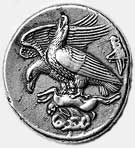
Plate 25 |

Plate 26 |
|
Predators and Prey on Ancient Greek Money
Art
Greek coins first appeared about 600 BCE and within a century had spread well beyond the mainland. Although the Greeks had no banks, from an economic standpoint the effort to standardize payments was revolutionary. From an artistic one, minting coins with images like the eagles seen here established a standard that endures to this day. The eagles conveyed a message to the citizenry, just as those on modern coins do now. Then, however, the birds were considered to be emissaries of Zeus, serving as omens and handing out punishment. Zeus had one eagle do to Prometheus more or less what an eagle appears to be doing to the hare in the coin. The circadian punishment--the eagle extracted Prometheus’s liver each day (the liver repaired itself each night)--was imposed for two acts of defiance. In the first he shorted Zeus a measure of sacrificial meat by providing a choice between two offerings: one contained ox entrails wrapped in fat, and the other contained choice bits of ox placed in its stomach. Zeus made a bad choice and in his rage took fire away from humanity. In the second act of defiance Prometheus returned fire to humanity, and in a second display of rage Zeus had Prometheus arrested and chained to a rock for the daily liver extractions. Eagles often appear on coins from
Page 2-->
|
Plate 25 Ten Drachma Silver Coin, Arkagas, Sicily,
c. 412–411 BCE, by an unknown artist
Photo credit: Max Hirmer. © Hirmer Fotoarchiv München.
Plate 26 Modified Detail of Ten Drachma Silver Coin, Arkagas, Sicily,
© 1990/2007 Darryl WheyeScience Art--Birds.
© 2008 Darryl Wheye and Donald Kennedy
|


